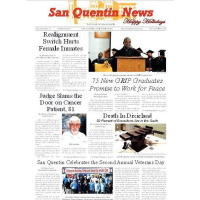San Quentin Newspaper Wins Journalism Award While on Suspension by Prison

The San Quentin News, the country’s only inmate-published newspaper, was honored last week by the Northern California Society of Professional Journalists for producing “extraordinary journalism under extraordinary circumstances.”
San Quentin prison authorities showed just how “extraordinary” those “circumstances” are when it suspended the newspaper for 45 days over the staff’s choice of a photograph in its December issue. The suspension ends February 15.
A prison spokesman wouldn’t tell the Los Angeles Times precisely what rules the inmates had violated, but said they had gone around the usual editorial process. An adviser to the newspaper, University of California, Berkeley professor William Drummond, said a photograph was substituted at the last second, after prison officials had signed off on it.
Online magazine Guernica offered more detail. It said a correctional officer had snapped a photo showing a “female volunteer casually touching an inmate,” in violation of prison policy. The officer OK’d the newspaper using the picture, but another official overruled him before the inmates went ahead and ran it anyway.
Although the newspaper is designed and edited by inmates, prison officials have the last word. Drummond said all the photographs in the possession of the inmates had been previously approved.
The newspaper is circulated in 16 other prisons through their libraries. Plans are to increase circulation 10-fold by mailing the paper to all 34 prisons in the California system. San Quentin has produced some form of newspaper on and off for nearly a century, according to Guernica. It was called the Wall City News in 1920s before being shut down in the ‘30s and restarted in the ‘40s by the celebrated progressive warden, Clinton T. Duffy.
Duffy, the warden from 1940-1952, also desegregated the dining hall, eliminated corporal punishment, established vocational training, facilitated the creation of the first in-prison radio programming, improved food services and oversaw the execution of 90 prisoners, although he opposed capital punishment. He co-wrote “88 Men and 2 Women” with Al Hirschberg in 1962, a best-seller that contributed to a 10-year moratorium on executions in the United States, which ended in 1977 with the killing of Gary Gilmore by a firing squad in Utah.
The modern version of the newspaper traces its lineage to 2008, when it was revived after a couple of decades of dormancy. In addition to help from Berkeley, Bay Area reporters and editors lend a hand in getting the paper out.
In recognizing the newspaper with one of its James Madison Freedom of Information Awards, the journalism organization cited the San Quentin News for its “scrutiny of prison authorities, . . . a prison hunger strike, overcrowding and denial of compassionate release for a dying inmate.”
The newspaper’s December front page sported a lead story about the negative effect realignment was having on female inmates. Reporters also covered the plight of an 81-year-old inmate with terminal cancer who was granted a compassionate release by one judge, only to have it revoked by another. A third story explored “Death in Dixieland,” where the South accounts for 82% of U.S. executions. There were also upbeat feature stories on the success of a rehabilitation program and a celebration of Veterans Day.
The San Quentin News tweets at twitter.com/SanQuentinNews.
–Ken Broder
To Learn More:
San Quentin Inmate-Run Newspaper Honored, Suspended (by Chris Megerian, Los Angeles Times)
Society of Professional Journalists Honors San Quentin News (Marin Independent Journal)
The News from San Quentin, Part 1 (by Jessica Pishko, Guernica)
The News from San Quentin, Part 2 (by Jessica Pishko, Guernica)
Newspaper Behind Bars Boasts Compelling Storytelling (by Chris Megerian, Los Angeles Times)
- Top Stories
- Controversies
- Where is the Money Going?
- California and the Nation
- Appointments and Resignations
- Unusual News
- Latest News
- California Forbids U.S. Immigration Agents from Pretending to be Police
- California Lawmakers Urged to Strip “Self-Dealing” Tax Board of Its Duties
- Big Oil’s Grip on California
- Santa Cruz Police See Homeland Security Betrayal in Use of Gang Roundup as Cover for Immigration Raid
- Oil Companies Face Deadline to Stop Polluting California Groundwater





